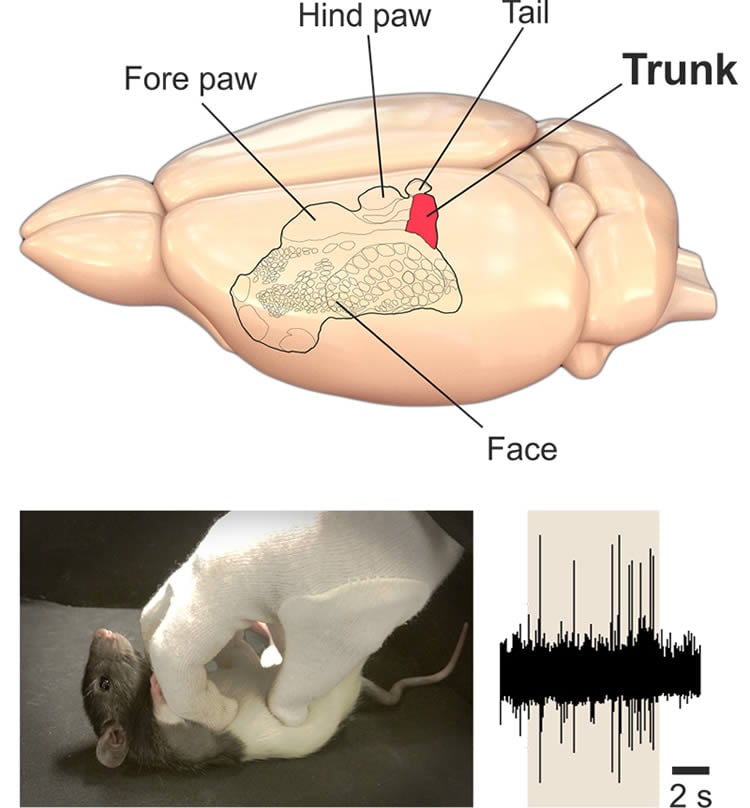Summary: Researchers have identified a ticklish spot in the rat brain.
Source: Humboldt-Universität zu Berlin.
A new study from Humboldt-Universität zu Berlin has found how “ticklishness” is represented in the rat brain. The study has been published on 11th November 2016 in Science.
Of all physical sensations, ticklishness is perhaps the most mysterious. Why do we laugh in response to tickling? Why are certain body parts more ticklish? Why cannot we tickle ourselves? Indeed, the mystery of ticklish perception has been discussed for more than two millennia by great intellectuals including Aristotle and Charles Darwin. Despite such long-standing interest, the mechanism of ticklishness remained elusive.

The new study investigated tickling in rats. Earlier work had shown that young rats respond with 50 kHz ultrasonic “laughter-calls” to tickling by humans. In the novel study rats also reacted enthusiastically to the tickling: they emitted numerous calls. As judged by their calls, rats were most ticklish on the belly and underneath their feet. Rats often performed unsolicited joy jumps (Freudensprünge) after tickling, a behavior that can be seen in joyful subjects in various mammalian species. Rats also played with the researcher’s hand and chased it, and emitted similar calls during play.
Perhaps ticklishness is a trick of the brain that rewards interacting”
The researchers (Shimpei Ishiyama & Michael Brecht) then went on to investigate the response of the rat’s brain to such tickling. Specifically, the investigators studied the rat’s somatosensory cortex, a large brain structure that contains an ordered representation of the body and handles stimuli on the body. In the trunk region of the somatosensory cortex, the researchers observed nerve cells that responded strongly to tickling. Interestingly, the researchers found very similar brain responses during play behaviours as during tickling, even though the rats were not touched by the scientist. Making rats anxious – which reduces ticklishness – also reduced the activity in these cells and suppressed the calls. Remarkably, rats emitted calls just to electric stimulation of the cells in the trunk region of the somatosensory cortex without being tickled. Taken together, these results suggest that activity in the trunk somatosensory cortex represents ticklish sensation.
The video describes why we are ticklish: Certain neuronal cells in the brain are activated by tickling and trigger laughter. These cells are also activated during play behaviour. Is this a trick of the brain to make us play?
Professor Michael Brecht, who led the study, says: “The data much look like we identified the ticklish spot in the rat brain. I also find the similarity of brain responses to tickling and play remarkable. Perhaps ticklishness is a trick of the brain that rewards interacting and playing.”
Funding: This study was supported by Bernstein Center for Computational Neuroscience Berlin, Humboldt-Universität zu Berlin, SFB665 and the Deutsche Forschungsgemeinschaft – Leibniz Prize.
Source: Dr. Michael Brecht – Humboldt-Universität zu Berlin
Image Source: This NeuroscienceNews.com image is credited to Ishiyama & Brecht.
Video Source: The video is credited to Bernstein Network.
Original Research: Abstract for “Neural correlates of ticklishness in the rat somatosensory cortex” by S. Ishiyama and M. Brecht in Science. Published online November 11 2016 doi:10.1126/science.aah5114
[cbtabs][cbtab title=”MLA”]Humboldt-Universität zu Berlin. “New Theory Debunks Idea That Math Abilities Are Inate.” NeuroscienceNews. NeuroscienceNews, 11 November 2016.
<https://neurosciencenews.com/touch-tickle-sensation-5484/>.[/cbtab][cbtab title=”APA”]Humboldt-Universität zu Berlin. (2016, November 11). New Theory Debunks Idea That Math Abilities Are Inate. NeuroscienceNews. Retrieved November 11, 2016 from https://neurosciencenews.com/touch-tickle-sensation-5484/[/cbtab][cbtab title=”Chicago”]Humboldt-Universität zu Berlin. “New Theory Debunks Idea That Math Abilities Are Inate.” https://neurosciencenews.com/touch-tickle-sensation-5484/ (accessed November 11, 2016).[/cbtab][/cbtabs]
Abstract
Neural correlates of ticklishness in the rat somatosensory cortex
Rats emit ultrasonic vocalizations in response to tickling by humans. Tickling is rewarding through dopaminergic mechanisms, but the function and neural correlates of ticklishness are unknown. We confirmed that tickling of rats evoked vocalizations, approach, and unsolicited jumps (Freudensprünge). Recordings in the trunk region of the rat somatosensory cortex showed intense tickling-evoked activity in most neurons, whereas a minority of cells were suppressed by tickling. Tickling responses predicted nontactile neural responses to play behaviors, which suggests a neuronal link between tickling and play. Anxiogenic conditions suppressed tickling-evoked vocalizations and trunk cortex activity. Deep-layer trunk cortex neurons discharged during vocalizations, and deep-layer microstimulation evoked vocalizations. Our findings provide evidence for deep-layer trunk cortex activity as a neural correlate of ticklishness.
“Neural correlates of ticklishness in the rat somatosensory cortex” by S. Ishiyama and M. Brecht in Science. Published online November 11 2016 doi:10.1126/science.aah5114






